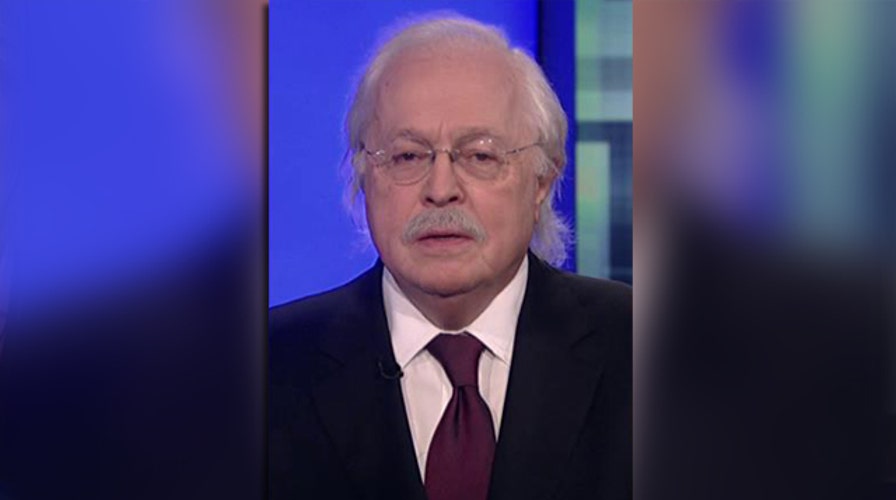Medical exam evidence vs. Garner grand jury decision
Dr. Michael Baden, hired by family of unarmed man killed in officer's chokehold, reflects his review of the medical examination and the grand jury's ruling
This is a rush transcript from "On the Record," December 3, 2014. This copy may not be in its final form and may be updated.
GRETA VAN SUSTEREN, FOX NEWS HOST: Joining us, forensic pathologist Dr. Michael Baden, who was hired by Eric Garner's family to review the medical examiner's findings. He is here to tell us what he found.
I'm having a hard time getting past the fact he says, "I can't breathe," which, to me, that's a real tipoff that that's a time to stop putting so much force on him. Tell me how easy was it to kill this man, because it certainly looks over the top to me.
DR. MICHAEL BADEN, FORENSIC PATHOLOGIST: You are absolutely right, Greta. And the findings of the autopsy were that he died because he couldn't breathe. And he had said that he couldn't breathe as this was progressing. There was pressure, not only compressing the neck, that interferes with breathing and oxygen flow, compressing the chest, but also compressing the face and mouth and nose area. So, he died clearly of, as medical examiner's office said, of inability to breathe.
VAN SUSTEREN: All right, so is it -- can you -- I'm trying to think why in the world the grand jury didn't indict. This is one of these instances where you actually get to watch it, not the situation where the grand jury is reviewing evidence that you may not see. We got to see this tape. From the time he says "I can't breathe" the first time, I mean, how much longer before he, you know, he died? What's that span of time? Can you determine that?
BADEN: That can be determined by looking at that film. Within a minute or so.
VAN SUSTEREN: That's a long time.
BADEN: Oh, yeah.
VAN SUSTEREN: A minute is a long time.
BADEN: Oh, yeah. First, he would lose consciousness but still be alive and able to be resuscitated, but after a minute or two, he would be -- there would be enough brain damage that he couldn't be resuscitated.
VAN SUSTEREN: All right. Once he loses consciousness, is that -- I mean, at that point, was he then going to die or was there still force likely applied to him that -- I mean, was he likely to regain consciousness if more force hadn't been applied?
BADEN: As you say, once he loses consciousness, he is unconscious but he is resuscitatable. He's not dead.
(CROSSTALK)
VAN SUSTEREN: So that means they continue to do it.
BADEN: Pardon me?
VAN SUSTEREN: That means they continued --
BADEN: Yeah.
VAN SUSTEREN: -- to apply pressure even after he is unconscious. Not even, "I can't breathe," but now he is unconscious and they still keep doing this?
BADEN: That's right. That's correct. But one of the things that happens in these takedowns and confrontations is individual police might not know he is unconscious because with the pulling and tugging, he may be thought to be still resisting or still conscious. He isn't entirely still because other people are pulling and tugging on him, other police are. But it was all the police, not just one police officer that would have caused the obstruction to breathing.
VAN SUSTEREN: All right. Is -- and this is no way to excuse what happened to him, but is his -- the fact that he was a man who was asthmatic with -- and he was obese and he had heart disease, would that make him more fragile so that, for instance, that force maybe applied to me wouldn't have killed me, but he is more fragile man because of his condition, and so he's more likely to have died than, for instance, a healthy person?
BADEN: Yeah, that's fair. His preexisting obesity and heart condition would have made him more at a risk from dying of asphyxia. But he wouldn't have died if the asphyxia hadn't been placed on him.
VAN SUSTEREN: Does it take a lot to do a chokehold on someone to asphyxiate someone? Could I have done it, for instance? I'm 5'3". Do I have another power to do that or does it take a lot of force?
BADEN: It takes a lot of force, because it's force on the neck itself that occludes the blood vessels going to the brain as well as the wind pipe. There is also pressure on the chest. That takes a lot of force to press the chest so that the diaphragm doesn't work and the lungs don't expand, is what the chess pressure does. Then there was, visible on the film, on the video, pressure on the face, the nose and the mouth, which also occludes breathing. So all together he died because he couldn't breathe. He might have died, you know, a little bit earlier than somebody who was in better health condition, but he would not have died if that pressure hadn't been put on him.
VAN SUSTEREN: Dr. Baden, thank you, sir.
BADEN: Thank you, Greta.

